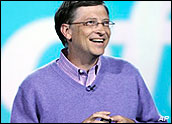
Palm has launched a new Treo smartphone aimed at the European market, saying the device was specifically designed for Vodafone’s third-generation high-speed mobile network.
The Treo 750v, also the first Palm device unveiled in Europe to use Windows Mobile 5.0, will launch in seven countries by the end of the year, including France, Germany, Ireland, Italy, Spain and the UK.
“Expanding the Treo footprint globally is a key focus for Palm, and with collaborative marketing investments in Europe from Palm, Vodafone and Microsoft, we are confident we can captivate mobile professionals and businesses and help them be more productive in the office and on the go,” said Palm CEO Ed Colligan.
The hand-held device will feature a mobile phone, mobile e-mail and messaging, Web browsing and mobile organizing functions. The device comes ready to use Microsoft’s push e-mail solution and is meant to compete for corporate customers with Research In Motion’s BlackBerry.
The device comes to market after several weeks of speculation. The schedule projected by Palm appears to have the device debuting in the U.S. well into or even after the key fourth quarter holiday shopping season.
Feature Rich
Palm is hoping to use the new device to gain ground in a market where RIM and Nokia have found traction, and which remains relatively small yet poised for growth. Yankee Group estimates that fewer than 5 million smartphones were sold in Europe last year, making up just 1 percent of total market for mobile devices.
However, the market for so-called “converged devices” is expected to explode to some US$50 billion annually worldwide by 2009, with Europe and its relatively advanced mobile networks the second largest space behind Asia.
Palm promised new devices would help lift its sales after it issued a disappointing quarterly report last week. In addition to the feature-laden 750v, Palm is expected to roll out a relatively affordable smartphone aimed at consumers and business users in the U.S. and elsewhere.
The new device is designed to attract European buyers because it is designed specifically for them, while earlier devices sold in Europe have been adaptations of devices first sold in the U.S.
Win for Microsoft?
The device also features new software upgrades to Windows Mobile, including Today Screen, which lets users dial their phones by typing in a few letters of a contact’s name or by clicking on a contact’s photo. It also includes enhanced security software built into the mobile operating system.
Because the mobile messaging market is still relatively small in Europe, Microsoft may be able to establish Windows Mobile there, said Endpoint Technologies analyst Roger Kay.
“Microsoft continues to invest in and evolve Windows Mobile even as device makers find the market growing slowly,” he said. Businesses that operate Windows on their networks and desktops and haven’t yet moved to adopt the BlackBerry for mobile e-mail may be more open to Windows devices for compatibility purposes, he added.
Even though smartphones still make up just a fraction of overall mobile device sales, device makers are aggressively jockeying for position, knowing that locking in users now will pave the way for future market share gains. That’s especially true in business settings, where corporations often want their employees standardized on one platform.
Earlier this week, Nokia said it would launch its new E62 smartphone in the U.S. and Canada later this month.




















































